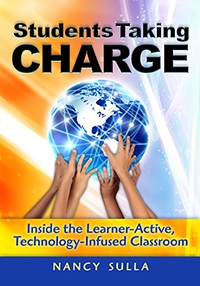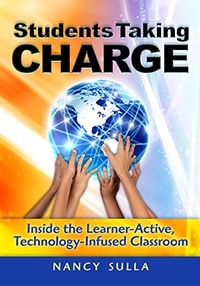[fusion_builder_container hundred_percent=”yes” overflow=”visible”][fusion_builder_row][fusion_builder_column type=”1_1″ background_position=”left top” background_color=”” border_size=”” border_color=”” border_style=”solid” spacing=”yes” background_image=”” background_repeat=”no-repeat” padding=”” margin_top=”0px” margin_bottom=”0px” class=”” id=”” animation_type=”” animation_speed=”0.3″ animation_direction=”left” hide_on_mobile=”no” center_content=”no” min_height=”none”]
Book: Students Taking Charge: Inside the Learner-Active, Technology-Infused Classroom
Author: Nancy Sulla
Publisher: Eye on Education
The high school classroom can be a challenging arena for teachers these days. With overcrowded sections and forced high stakes testing, the opportunity for creativity and student-focused learning has been slowly squeezed out of the high school experience. While corporate education “reformers” continue to push the standardized test method of judging student “achievement,” thankfully, there are educators who pursue truly effective methods of teaching. In Students Taking Charge: Inside the Learner-Active, Technology-Infused Classroom, Nancy Sulla combines the two trends that are most connected to today’s teenagers to create a whole new paradigm for the high school classroom:
Passionate teachers see beyond the barriers; they know there is a better way to prepare young people for their future and to unleash in them all the potential they possess. They explore new ways of approaching teaching and learning, and, fueled by isolated and sometimes small encounters with success, they forge ahead.
As we’ve mentioned before here at The Educator’s Room, high school education is swiftly changing. Our students are faced more and more with the contradiction that they need a relevant learning experience; yet possess minds that function in a completely different way than traditional education is designed. Sulla begins by confronting that age-old resistance to change in the classroom: “but it’s always been that way!” Shifting our mindsets to an entirely new generation of learners is the way we will make our teaching relevant and give students the tools with which to leave high school as functioning, self-sustaining human beings. To do that, she creates a new classroom dynamic based on three goals: (1) To have engaged learners, (2) student responsibility for their own learning, and (3) academic rigor.
The first step to understanding how to change our paradigm for teaching teenagers in the 21st century is to recognize some truths about the Internet Generation. According to Sulla, these teenagers are:
- Strong on independence and autonomy
- They are used to emotional and intellectual openness
- They tend towards inclusiveness
- They believe in free expression and strong views
- They are innovative and know how to troubleshoot
- They can be preoccupied with maturity
- They love to engage in investigations
- They thrive on immediacy (instant gratification)
- They are skeptical of corporate messaging
- They are concerned with authentication
Taking these aspects into account, a teacher can redesign the high school learning experience so that students can incorporate their contemporary experiences with essential academics. The plan is a simply one that combines student ownership and technology: First, start with a core problem for students to solve. Setting them on an investigation and problem-solving journey is immediately more engaging for them, and they can use their individual abilities to greater strengths. The idea is to scaffold the content based on a “felt need.” This means that whatever the problem is to solve, the content will lend itself to that end. Sulla suggests starting with standards (CCSS fit very well into this model), move to what problem can be solved, infuse the journey with meaning and relevancy and focus on the known and unknown issues along the way. It allows for incredible innovation and room for differentiated instruction throughout the content. The idea of finding student buy-in through problem solving is based on many years of research, most notably, we know from Sousa (2005) that students will retain information much longer if it comes to them with relevancy and meaning.
Sulla envisions it this way:
Imagine a learning environment in which students pose questions and actively seek answers. They decide how they will use their time; take charge of setting and achieving goals; and work individually to build skills and collaboratively develop solutions to real-world problems.
But this is not just pie-in-the-sky thinking. Sulla has provided pages and pages of ideas about how to craft lessons, incorporate rubrics and use technology so that it is a tool in the hands of innovative students and not simply a means to the same old end. She dives into a revised version of Bloom’s Taxonomy and combines tried and true methodologies, including Vygotsky’s Zone of Proximinal Development, Gartner’s Multiple Intelligences and Glasser’s Choice Theory, to create new dynamics for any high school classroom. There are even practical suggestions for physical classroom designs that can aid in shifting your teaching arena into one of student-owned engagement. Her ideas are ones easily transferable to your personal teaching methods, whether you are looking to infuse your classroom with more collaboration, more meaningful use of technology, more rigorous academic standards, or additional skills necessary for your students to be successful outside school.
The ten principles that Sulla suggest for a “Learner-Active, Technology-Based” classroom are:
♦ Higher-Order, Open-Ended Problem Solving
♦ High Academic Standards
♦ Learning from a Felt Need
♦ Global Citizenship
♦ Technology Infusion
♦ Individual Learning Path
♦ Student Responsibility for Learning
♦ Connected Learning
♦ Collaboration
♦ High Social Capital
The practical nature of this book makes for easy reading for busy teachers, but also offers actual rubrics, useful scaffolding plans, and ideas for assessments and common core connections that are essential for planning. Each chapter offers dynamic ideas and ways to make big or small changes in the way you operate as a high school teacher. The nature of teaching that is student-led and technology-infused is that it can be applied in any classroom, even ones that currently must focus on standardized testing for some of the year.
This book provides a road map to achieving the above principles in your classroom. As a non-traditional teacher, I found this book also incredibly useful. I teach in a variety of venues, including online and in small groups, and all of the recommendations in this book apply to my non-traditional students as well, so it is versatile no matter where or how you teach. One issue remains clear: teenagers of the 21st century are not the same as those of the industrialization era when our schools were designed. It’s time we move beyond “it’s always been that way!” to the new horizons that offer student empowerment, meaningful use of technology, and teachers whose expertise in these areas is essential for the modern high school student.
To buy Cari’s book that details her sudden unemployment, “How to Finish the Test When Your Pencil Breaks” please click here.
—
Disclaimer: This book was provided to The Educator’s Room free of charge by the publisher. However, neither The Educator’s Room nor the reviewer received any compensation for this review. The opinions contained in this review are those of the reviewer alone and were written free of any obligation or agreement with the publisher. If you have any questions regarding book reviews, see our full disclaimer or contact the Book Review Editor.
[/fusion_builder_column][/fusion_builder_row][/fusion_builder_container]






Leave a comment